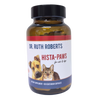Emergencies often catch us off guard. Whether it’s a natural disaster, sudden illness, or unexpected travel, having a plan in place for your pets can make a big difference in how quickly and effectively you respond.
Dogs and cats don’t get hurt or sick on a schedule—and sometimes it happens when help isn’t immediately available. That’s why creating a Pet Emergency Kit is one of the most practical and loving things you can do as a pet parent.
Why You Need an Emergency Kit for Your Pet
Having an emergency kit isn’t about replacing professional veterinary care—it’s about bridging the gap until you can get to the vet. Whether it’s a long weekend, you're traveling, or a storm disrupts local services, your emergency kit acts as a backup plan. With the right tools and knowledge on hand, you may be able to stabilize or manage a situation at home before seeking help.
It's especially helpful during:
-
Hurricanes, wildfires, or floods
-
Extended travel or relocation
-
After-hours emergencies or holiday closures
Keeping your pet safe, comfortable, and supported until they can get proper care is what this kit is all about.
What to Keep in Your Pet’s Emergency Kit
Here’s what to include, based on common scenarios:
Gastrointestinal (GI) Upset
GI Upset is one of the most common “emergencies” that pet parents face. Since our pets can’t tell us more about why they’re vomiting, this often feels very urgent for pet parents. And while nausea and vomiting can be signs of serious illness, sometimes our pets just get a little tummy upset.
What to do:
-
Withhold food for 12 hours after vomiting
-
Continue offering water
-
Reintroduce bland food gradually
-
Monitor for signs of dehydration or continued vomiting
Keep on hand:
-
✅ Probiotics – To support digestive balance
-
✅ Activated Charcoal – For digestive disturbances
-
✅ Fiber-rich foods – Like pumpkin, sweet potato, banana, or turnips (shelf-stable is best)
Bleeding or Minor Trauma
In the middle of an emergency, whether you're evacuating during a storm or traveling far from home, accidents can happen fast. A cut from broken glass, a scrape from debris, or a minor injury during a stressful moment can be unsettling. Having a few basics on hand and knowing how to respond calmly can make all the difference while you get your pet the help they need.
What to do:
-
Apply pressure with a clean cloth
-
Flush with clean water
-
Cover with gauze and secure with wrap
-
Assess for deeper wounds
-
Monitor for signs of infection
Keep on hand:
-
✅ Sterile gauze pads
-
✅ VetWrap or self-adhesive bandages
-
✅ Yunnan Baiyao – Commonly used for bleeding
-
✅ Saline or bottled water
-
✅ Epsom salt – To soak small wounds (with vet guidance)
Sprains, Strains, or Overexertion
Pets can overdo it during play or get sore with age. Older pets are especially prone to joint and muscle strain.
What to do:
-
Limit movement and offer rest
-
Monitor for limping or changes in behavior
-
Use cooling packs if swelling is present
-
Look for signs of pain like panting, vocalizing, or reluctance to move
Keep on hand:
-
✅ NSAIDs approved by your vet
-
✅ Inflapotion or Herbaprin – Natural support for occasional discomfort
-
✅ Cold pack or ice pack for swelling
Stress or Travel-Related Discomfort
Emergencies and sudden changes, like evacuations, car rides, or noisy shelters, can be overwhelming for pets. Even the calmest dog or cat might feel anxious when routines are disrupted. Having a few calming tools on hand can help ease the tension and make these stressful moments a little more manageable for both of you.
What to do:
-
Create a calm environment
-
Use calming tools before stressful situations
-
Keep hydration accessible
Keep on hand:
-
✅ Liquid Nutricalm – A calming herbal tincture
-
✅ Portable water bowl or bottle
-
✅ Familiar blanket or soft towel
Additional Essentials for Any Emergency
No matter the situation, these general items are always helpful:
✅ Leash and collar with ID tags
✅ Muzzle (soft type) – For safety during handling
✅ Disposable gloves
✅ Flashlight or headlamp
✅ Copy of vaccination records and medications
✅ Emergency contact list – Vet, nearest ER, poison control
✅ Towel or blanket – Comfort or transport aid
Final Thoughts: Plan Ahead, Stay Calm
You never know when an emergency will happen—but with a well-stocked kit and a basic understanding of what to do, you can protect your pet while buying time for professional care. Always trust your instincts: if your pet can’t keep down water, has trouble breathing, or is in visible pain, don’t wait—seek veterinary help immediately.
This kit isn't just about supplies—it’s about peace of mind. Because your pet is family, and their safety matters as much as yours.
















